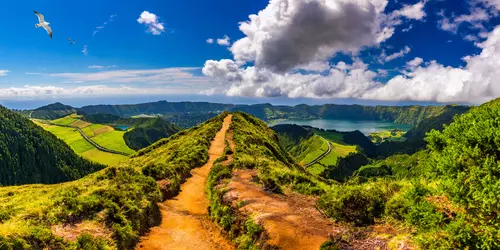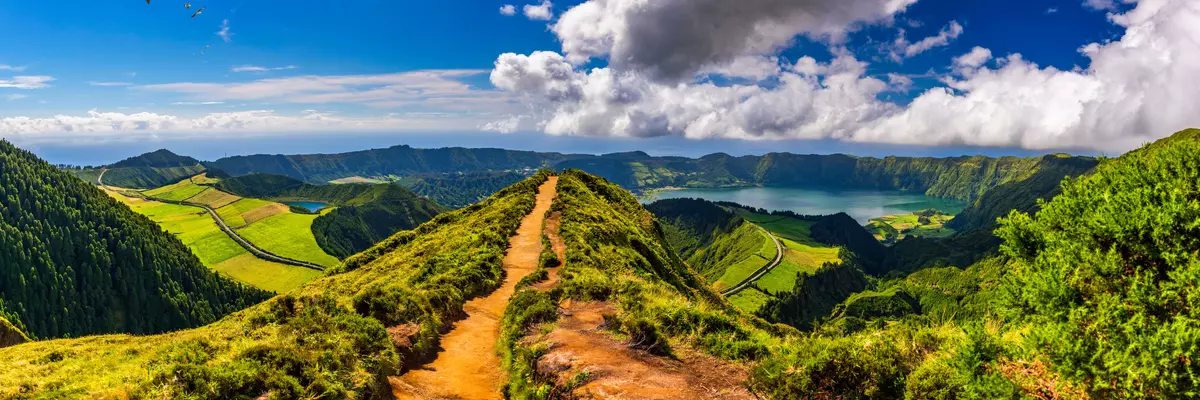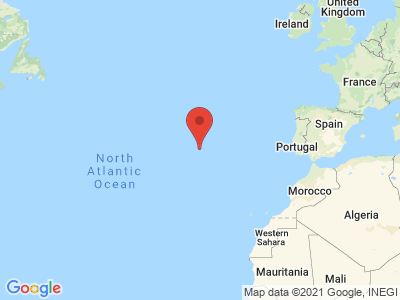Climate Table Azores
Jan | Feb | Mar | Apr | May | Jun | Jul | Aug | Sep | Oct | Nov | Dec | |
|---|---|---|---|---|---|---|---|---|---|---|---|---|
| Max. Temperature | 14° | 15° | 17° | 20° | 21° | 25° | 27° | 28° | 26° | 22° | 17° | 15° |
| Min. Temperature | 8° | 8° | 10° | 12° | 13° | 15° | 17° | 17° | 17° | 14° | 11° | 9° |
| Sun Hours | 5 | 6 | 6 | 9 | 10 | 11 | 12 | 11 | 9 | 8 | 6 | 5 |
| Water Temperature | 18° | 17° | 17° | 17° | 18° | 19° | 21° | 22° | 23° | 22° | 20° | 19° |
| Rain Days | 11 | 8 | 11 | 7 | 7 | 2 | 1 | 1 | 4 | 7 | 9 | 11 |
The climate year of Azores
Nine large islands and numerous small land masses form the Azores in the Atlantic Ocean on a total area of about 2333 square kilometers. The area belongs to the Mid-Atlantic Ridge and lies directly on the plate boundary between the African and Eurasian continental plates. Because of this location, the wind in the Azores frequently changes direction. On their long journey across the ocean, the air masses collect a lot of moisture, which causes large cloud layers to form. In general, precipitation is less frequent in the east than in the west of the archipelago. The sea water is continuously warmed by the Gulf Stream. Only the sub-islands of Flores and Corvo are located on the North American Plate. The easternmost point of the Azores is 1369 kilometers away from the European mainland. Except for the sub-island of Santa Maria, which consists of sedimentary rocks, all the components of the Azores are volcanic islands. São Miguel is the largest land mass among the islands. Ponta Delgada, the capital, is also located there. As an autonomous region of Portugal the Azores belong to the European Union.
General information about Azores
One of the most important places in the Azores from a cultural point of view is the old town of Angra do Heroísmo on the Terceira sub-island, which was declared a World Heritage Site by UNESCO in 1983. Besides the city park and the castle, the cathedral is especially worth seeing. The 2351 meter high volcano Pico on the island of the same name is the highest elevation in Portugal. Lake Furnas on São Miguel is also a popular destination in the Azores. On the same island, a visit to the Terra Nostra Park is possible. This botanical garden contains many unique plant species and provides a safe habitat for countless animal species. For a seaside vacation, it is recommended to book accommodation mainly on the southern islands. There you will find sandy beaches with a particularly lively environment. In addition, many large thermal baths are used in the cities. On the northern coasts, suitable bathing places are marked because of dangerous currents.
Tourism Azores
Although monthly temperature conditions change minimally in the Azores, the rainy days in a year are not evenly distributed among all months. From December to April, humidity is particularly high on the islands, with slightly cooler temperatures. Winds also blow unusually strongly during this period. Rain, fog and real storms occur more frequently as a result. During a real winter storm, the wind sometimes picks up a dangerous speed. Temperatures generally feel colder at the beginning of the year because of the high humidity relative to the reading on a thermometer. Nevertheless, the freezing point is not even approached. On sunny days, long hikes with pleasant weather conditions are easily possible during the winter months. Between June and October, a beach vacation is possible in the Azores. The optimal conditions for a stay at the beach are in July and August. But even in these two months, despite the pleasant warmth, you have to expect about five rainy days each. Even in summer, the weather is unpredictable because of the winds flowing from many different directions.


